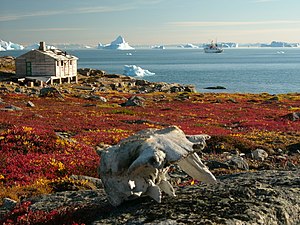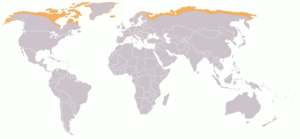Tundra climate
| Tundra | |
|---|---|

Tundra in Greenland
|
|

Map showing Arctic tundra
|
|
| Geography | |
| Area | 11,563,300 km2 (4,464,600 sq mi) |
| Climate type | ET |
In physical geography, tundra is a type of biome where the tree growth is hindered by low temperatures and short growing seasons. The term tundra comes through Russian тундра (tûndra) from the Kildin Sami word tūndâr "uplands", "treeless mountain tract". There are three types of tundra: Arctic tundra,alpine tundra, and Antarctic tundra. In tundra, the vegetation is composed of dwarf shrubs, sedges and grasses, mosses, and lichens. Scattered trees grow in some tundra regions. The ecotone (or ecological boundary region) between the tundra and the forest is known as the tree line or timberline.
Arctic tundra occurs in the far Northern Hemisphere, north of the taiga belt. The word "tundra" usually refers only to the areas where the subsoil is permafrost, or permanently frozen soil. (It may also refer to the treeless plain in general, so that northern Sápmi would be included.) Permafrost tundra includes vast areas of northern Russia and Canada. The polar tundra is home to several peoples who are mostly nomadic reindeer herders, such as the Nganasan and Nenets in the permafrost area (and the Sami in Sápmi).
Arctic tundra contains areas of stark landscape and is frozen for much of the year. The soil there is frozen from 25–90 cm (10–35 in) down, and it is impossible for trees to grow. Instead, bare and sometimes rocky land can only support low growing plants such as moss, heath (Ericaceae varieties such as crowberry and black bearberry), and lichen. There are two main seasons, winter and summer, in the polar tundra areas. During the winter it is very cold and dark, with the average temperature around −28 °C (−18 °F), sometimes dipping as low as −50 °C (−58 °F). However, extreme cold temperatures on the tundra do not drop as low as those experienced in taiga areas further south (for example, Russia's and Canada's lowest temperatures were recorded in locations south of the tree line). During the summer, temperatures rise somewhat, and the top layer of seasonally-frozen soil melts, leaving the ground very soggy. The tundra is covered in marshes, lakes, bogs and streams during the warm months. Generally daytime temperatures during the summer rise to about 12 °C (54 °F) but can often drop to 3 °C (37 °F) or even below freezing. Arctic tundras are sometimes the subject of habitat conservation programs. In Canada and Russia, many of these areas are protected through a national Biodiversity Action Plan.
...
Wikipedia
